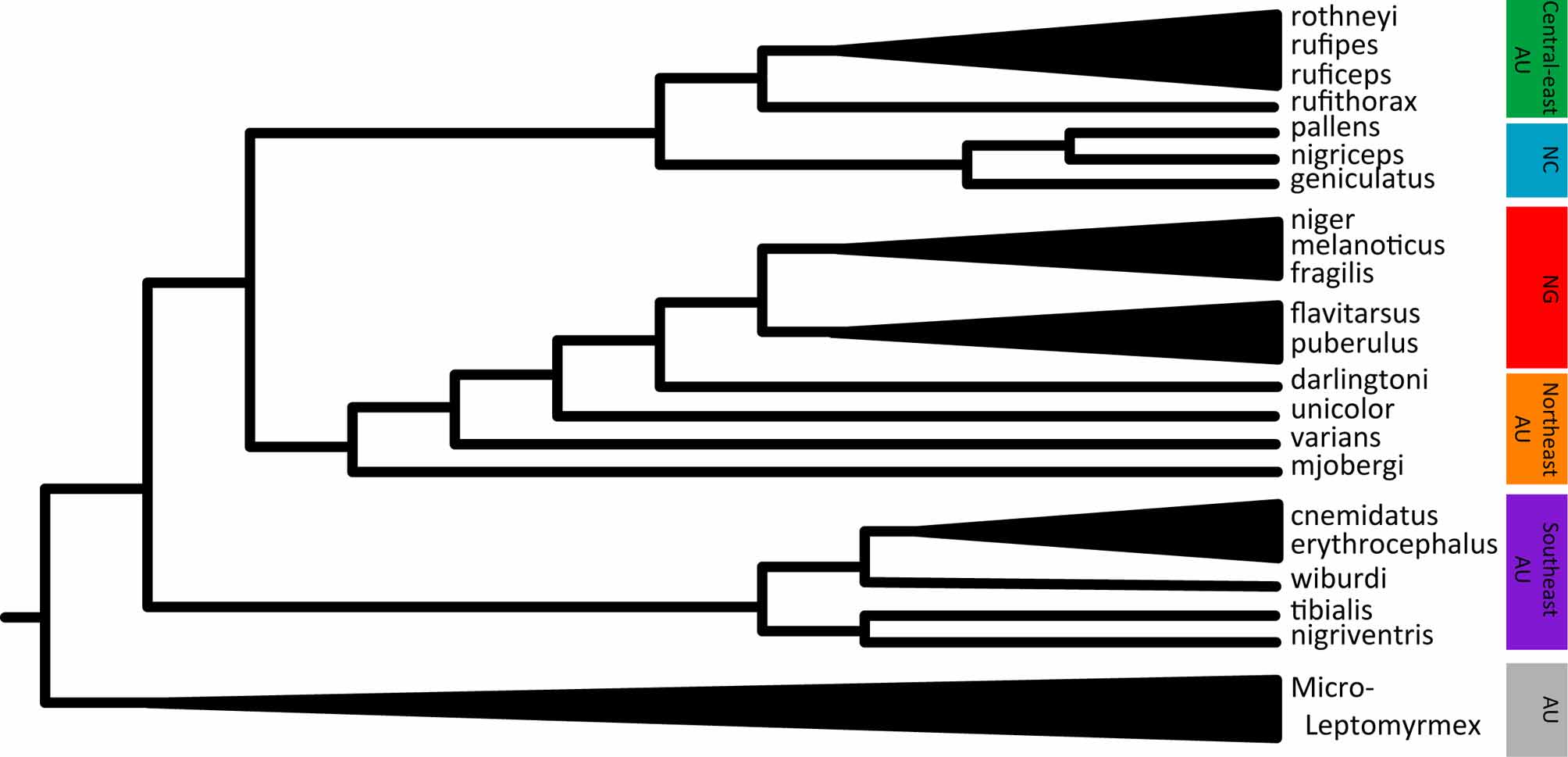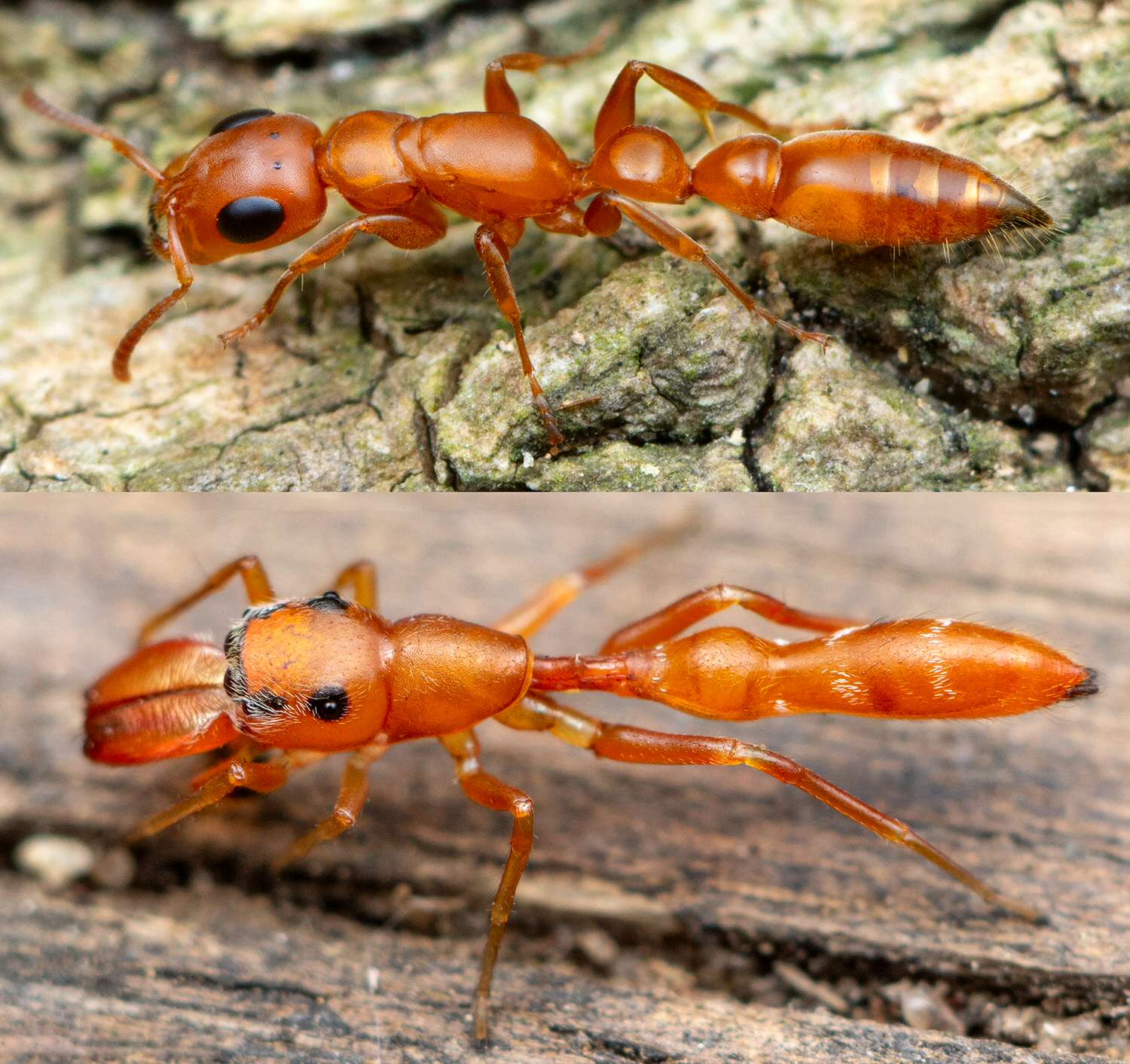|
Leptomyrmex
A video on how Spider Ant colonies function) ''Leptomyrmex'', or spider ants, is a genus of ants and a distinctive member of the ant subfamily Dolichoderinae. Commonly known as "spider ants" for their long legs and spider-like movements, these orange and black ants are prominent residents of intact wet forest and sclerophyll habitats throughout their range. One extant species, '' Leptomyrmex relictus'', is known from central Brazil; otherwise, the global distribution of this genus is restricted to eastern Australia, New Caledonia and New Guinea, as well as the nearby Indonesian islands of Aru and Seram. Newly hatched '' Extatosoma tiaratum'' stick insects mimic these ants to avoid predation. Workers of ''Leptomyrmex'' can be easily recognized by elongate antennal scapes which surpass the posterior margin of the head by more than one half their length, a medially notched hypostoma, mandibles with 7–15 teeth and 5–12 denticles, and a laterally located anterior tentorial pit. Qu ... [...More Info...] [...Related Items...] OR: [Wikipedia] [Google] [Baidu] |
Leptomyrmex Relictus
A video on how Spider Ant colonies function) ''Leptomyrmex'', or spider ants, is a genus of ants and a distinctive member of the ant subfamily Dolichoderinae. Commonly known as "spider ants" for their long legs and spider-like movements, these orange and black ants are prominent residents of intact wet forest and sclerophyll habitats throughout their range. One extant species, ''Leptomyrmex relictus'', is known from central Brazil; otherwise, the global distribution of this genus is restricted to eastern Australia, New Caledonia and New Guinea, as well as the nearby Indonesian islands of Aru Islands, Aru and Seram. Newly hatched ''Extatosoma tiaratum'' stick insects ant mimicry, mimic these ants to avoid predation. Workers of ''Leptomyrmex'' can be easily recognized by elongate Antenna (biology), antennal scapes which surpass the posterior margin of the head by more than one half their length, a medially notched hypostoma, Mandible (insect mouthpart), mandibles with 7–15 teeth and ... [...More Info...] [...Related Items...] OR: [Wikipedia] [Google] [Baidu] |
Leptomyrmex Darlingtoni
''Leptomyrmex darlingtoni'' is a species of ant in the genus ''Leptomyrmex''. Described by William Morton Wheeler in 1934, the species is endemic to Australia Australia, officially the Commonwealth of Australia, is a Sovereign state, sovereign country comprising the mainland of the Australia (continent), Australian continent, the island of Tasmania, and numerous List of islands of Australia, sma .... References External links * Dolichoderinae Hymenoptera of Australia Insects described in 1934 {{Dolichoderinae-stub ... [...More Info...] [...Related Items...] OR: [Wikipedia] [Google] [Baidu] |
Leptomyrmex Erythrocephalus
''Leptomyrmex erythrocephalus'' is a species of ant in the genus ''Leptomyrmex''. Described by Johan Christian Fabricius in 1775, the species is endemic to Australia Australia, officially the Commonwealth of Australia, is a Sovereign state, sovereign country comprising the mainland of the Australia (continent), Australian continent, the island of Tasmania, and numerous List of islands of Australia, sma .... References Dolichoderinae Hymenoptera of Australia Insects described in 1775 Taxa named by Johan Christian Fabricius {{Dolichoderinae-stub ... [...More Info...] [...Related Items...] OR: [Wikipedia] [Google] [Baidu] |
Leptomyrmex Ramorniensis
''Leptomyrmex ramorniensis'' is a species of ant in the genus ''Leptomyrmex A video on how Spider Ant colonies function) ''Leptomyrmex'', or spider ants, is a genus of ants and a distinctive member of the ant subfamily Dolichoderinae. Commonly known as "spider ants" for their long legs and spider-like movements, these orang ...''.Smith, D. J. & Shattuck, S. O., 2009, Six new, unusually small ants of the genus ''Leptomyrmex'' (Hymenoptera: Formicidae)., Zootaxa (2142), pp. 57-68: 66-67 References Dolichoderinae Hymenoptera of Australia Insects described in 2009 {{Dolichoderinae-stub ... [...More Info...] [...Related Items...] OR: [Wikipedia] [Google] [Baidu] |
Leptomyrmex Burwelli
''Leptomyrmex burwelli'' is a species of ant in the genus ''Leptomyrmex A video on how Spider Ant colonies function) ''Leptomyrmex'', or spider ants, is a genus of ants and a distinctive member of the ant subfamily Dolichoderinae. Commonly known as "spider ants" for their long legs and spider-like movements, these orang ...''.Smith, D. J. & Shattuck, S. O., 2009, Six new, unusually small ants of the genus Leptomyrmex (Hymenoptera: Formicidae)., Zootaxa (2142), pp. 57-68: 60-61 References Dolichoderinae Hymenoptera of Australia Insects described in 2009 {{Dolichoderinae-stub ... [...More Info...] [...Related Items...] OR: [Wikipedia] [Google] [Baidu] |
Leptomyrmex Aitchisoni
''Leptomyrmex aitchisoni'' is a species of ant in the genus ''Leptomyrmex A video on how Spider Ant colonies function) ''Leptomyrmex'', or spider ants, is a genus of ants and a distinctive member of the ant subfamily Dolichoderinae. Commonly known as "spider ants" for their long legs and spider-like movements, these orang ...''.Smith, D. J. & Shattuck, S. O., 2009, Six new, unusually small ants of the genus ''Leptomyrmex'' (Hymenoptera: Formicidae)., Zootaxa (2142), pp. 57-68: 59 References Dolichoderinae Hymenoptera of Australia Insects described in 2009 {{Dolichoderinae-stub ... [...More Info...] [...Related Items...] OR: [Wikipedia] [Google] [Baidu] |
Leptomyrmex Dolichoscapus
''Leptomyrmex dolichoscapus'' is a species of ant in the genus ''Leptomyrmex A video on how Spider Ant colonies function) ''Leptomyrmex'', or spider ants, is a genus of ants and a distinctive member of the ant subfamily Dolichoderinae. Commonly known as "spider ants" for their long legs and spider-like movements, these orang ...''.Smith, D. J. & Shattuck, S. O., 2009, Six new, unusually small ants of the genus ''Leptomyrmex'' (Hymenoptera: Formicidae)., Zootaxa (2142), pp. 57-68: 61-63 References Dolichoderinae Hymenoptera of Australia Insects described in 2009 {{Dolichoderinae-stub ... [...More Info...] [...Related Items...] OR: [Wikipedia] [Google] [Baidu] |
Ant Mimicry
Ant mimicry or myrmecomorphy is mimicry of ants by other organisms. Ants are abundant all over the world, and potential predators that rely on vision to identify their prey, such as birds and wasps, normally avoid them, because they are either unpalatable or aggressive. Spiders are the most common ant mimics. Additionally, some arthropods mimic ants to escape predation (protective mimicry), while others mimic ants anatomically and behaviourally to hunt ants in aggressive mimicry. Ant mimicry has existed almost as long as ants themselves; the earliest ant mimics in the fossil record appear in the mid Cretaceous alongside the earliest ants. Indeed one of the earliest, ''Burmomyrma'', was initially classified as an ant. In Wasmannian mimicry, mimic and model live commensally together; in the case of ants, the model is an inquiline in the ants' nest. Wasmannian mimics may also be Batesian or aggressive mimics. To simulate ants' powerful defences, mimics may imitate ants chemically w ... [...More Info...] [...Related Items...] OR: [Wikipedia] [Google] [Baidu] |
Dolichoderinae
Dolichoderinae is a subfamily of ants, which includes species such as the Argentine ant (''Linepithema humile''), the erratic ant, the odorous house ant, and the cone ant. The subfamily presents a great diversity of species throughout the world, distributed in different biogeographic realms, from the Palearctic, Nearctic, Afrotropical region and Malaysia, to the Middle East, Australian, and Neotropical regions. This subfamily is distinguished by having a single petiole (no post-petiole) and a slit-like orifice, from which chemical compounds are released. Dolichoderine ants do not possess a sting, unlike ants in some other subfamilies, such as Ponerinae and Myrmicinae, instead relying on the chemical defensive compounds produced from the anal gland. Of the compounds produced by dolichoderine ants, several terpenoids were identified including the previously unknown iridomyrmecin, isoiridomyrmecin, and iridodial. Such compounds are responsible for the smell given off by ants of ... [...More Info...] [...Related Items...] OR: [Wikipedia] [Google] [Baidu] |
Extatosoma Tiaratum
''Extatosoma tiaratum'', commonly known as the spiny leaf insect, the giant prickly stick insect, Macleay's spectre, or the Australian walking stick, is a large species of Australian stick insect endemic to Australia. The species has the Phasmid Study Group number PSG9. Range ''E. tiaratum'' is native to Queensland ) , nickname = Sunshine State , image_map = Queensland in Australia.svg , map_caption = Location of Queensland in Australia , subdivision_type = Country , subdivision_name = Australia , established_title = Before federation , established_ ... and New South Wales but has extralimital distribution as far away as New Guinea. Description Female adult ''E. tiaratum'' are covered with thorn (botany), thorn-like spikes for defense and camouflage. Their long, rounded bodies grow to about 20 cm long. The females are further described as "heavy-bodied, brachypterous and having numerous spines and integumental expansions on the face and legs, including a tuft ... [...More Info...] [...Related Items...] OR: [Wikipedia] [Google] [Baidu] |
Mesosoma
The mesosoma is the middle part of the body, or tagma, of arthropods whose body is composed of three parts, the other two being the prosoma and the metasoma. It bears the legs, and, in the case of winged insects, the wings. In hymenopterans of the suborder Apocrita (wasps, bees and ants), it consists of the three thoracic segments and the first abdominal segment (the propodeum). For historical reasons, in ants it is commonly referred to by the alternative name alitrunk. In scorpions, it is composed of six segments and forms the first part of the abdomen, containing all of the major organs. The first segment contains the sexual organs as well as a pair of vestigial and modified appendages forming a structure called the genital operculum. The second segment bears a pair of featherlike sensory organs known as the pectines; the final four segments each contain a pair of book lungs. The mesosoma is armoured with chitinous plates, on the upper surface by the tergites and on the low ... [...More Info...] [...Related Items...] OR: [Wikipedia] [Google] [Baidu] |
Genus
Genus ( plural genera ) is a taxonomic rank used in the biological classification of extant taxon, living and fossil organisms as well as Virus classification#ICTV classification, viruses. In the hierarchy of biological classification, genus comes above species and below family (taxonomy), family. In binomial nomenclature, the genus name forms the first part of the binomial species name for each species within the genus. :E.g. ''Panthera leo'' (lion) and ''Panthera onca'' (jaguar) are two species within the genus ''Panthera''. ''Panthera'' is a genus within the family Felidae. The composition of a genus is determined by taxonomy (biology), taxonomists. The standards for genus classification are not strictly codified, so different authorities often produce different classifications for genera. There are some general practices used, however, including the idea that a newly defined genus should fulfill these three criteria to be descriptively useful: # monophyly – all descendants ... [...More Info...] [...Related Items...] OR: [Wikipedia] [Google] [Baidu] |



.jpg)
